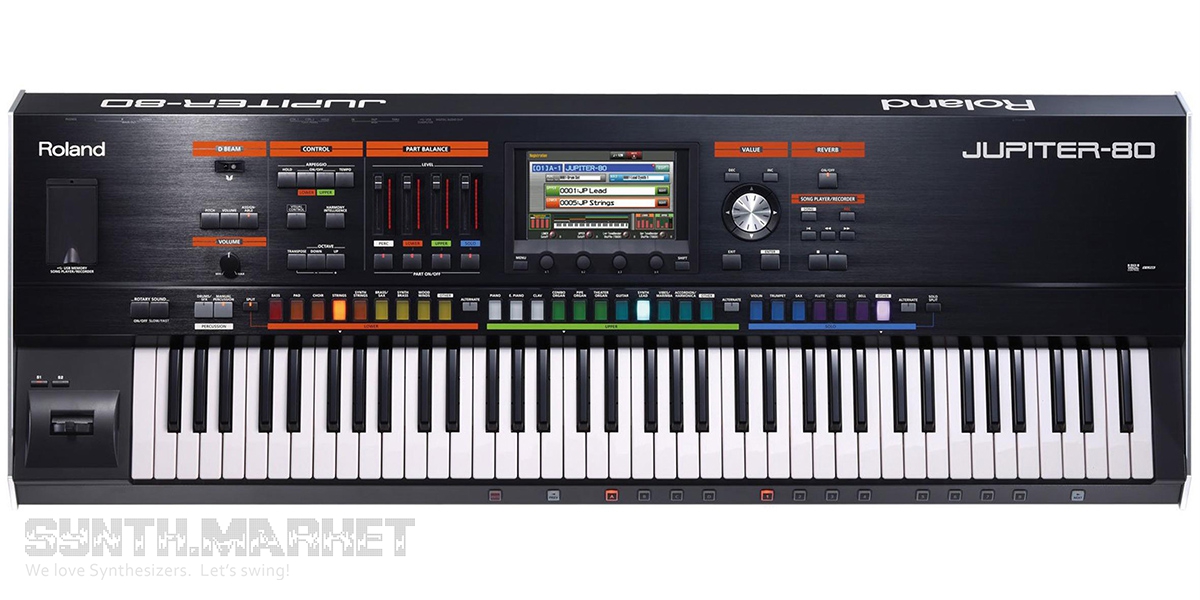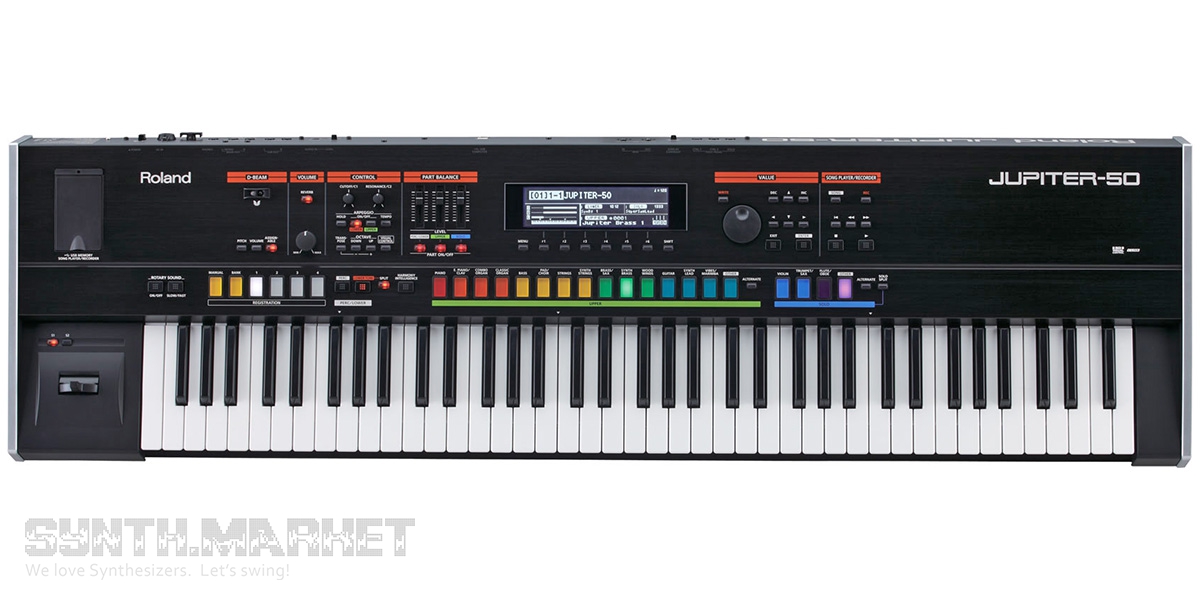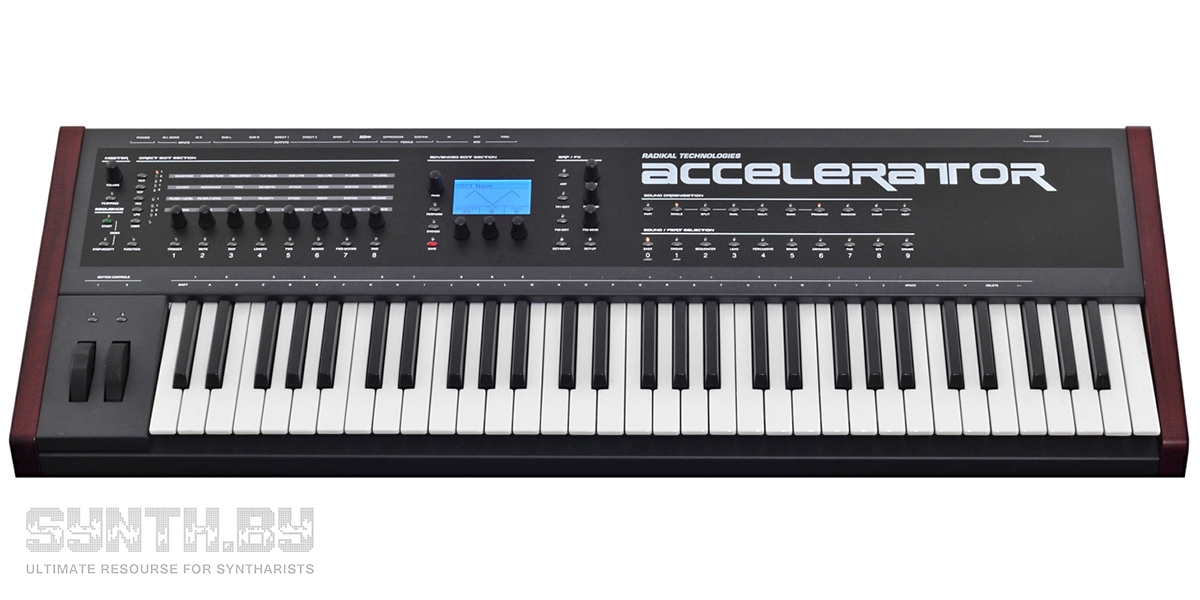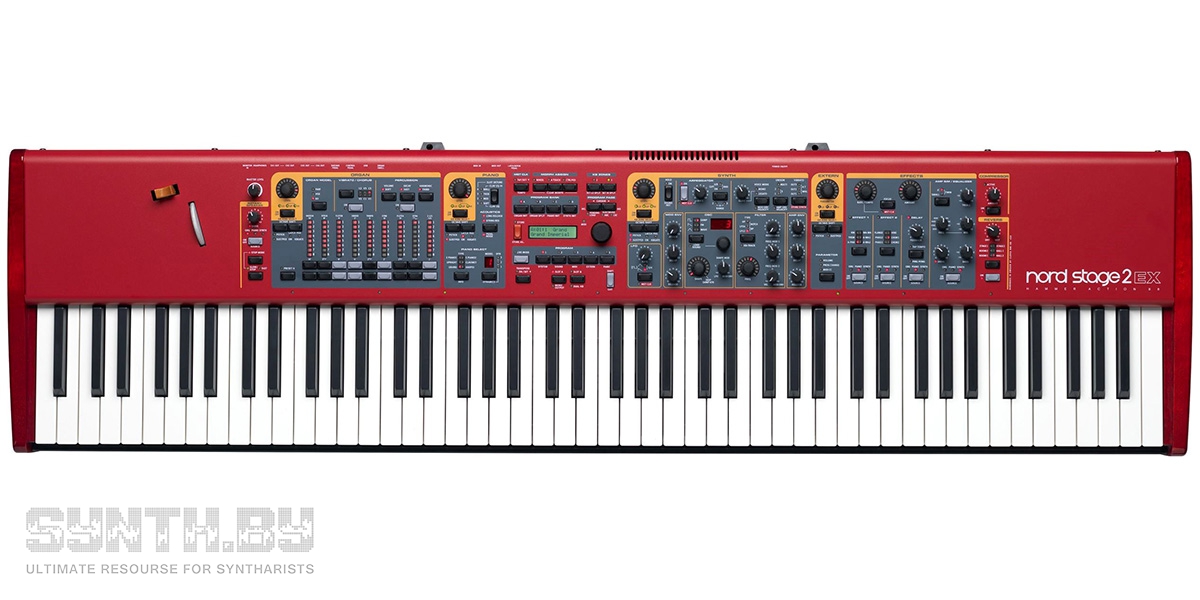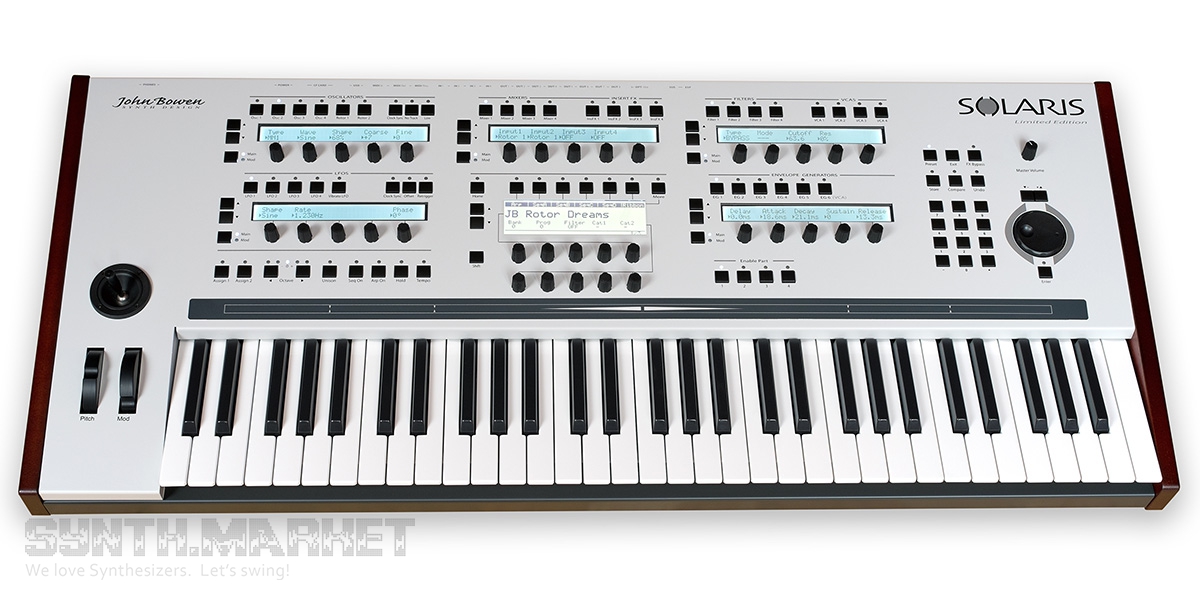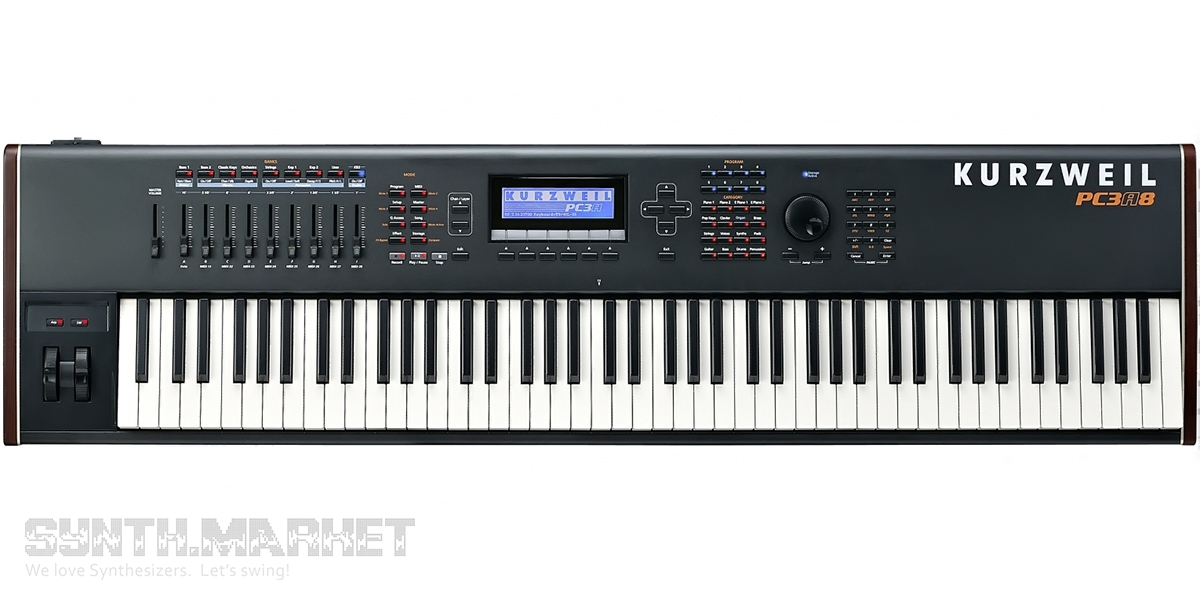Roland didn’t plan to make Jupiter 8 out of Jupiter-80 but it wouldn’t be fair to claim that JP-80 let the brand name down and tricked us into buying the meretricious concept. A 100% digital synth engine of the new Jupiter is based on SuperNATURAL technology sampling each note of a real instrument. Behaviour Modelling Technology re-creates all the nuances of each instrument analyzing the playing technics during a performance and introduces the peculiar features into sample sounds to give them more expression. A 76-note semi-weighted keyboard with aftertouch allows delivering truly convincing strings and wind instruments. Natural slides will give you the smoothest legato playing and punchy key pressing will seem so deceptive you might take it for real strings.
It has a too humble control panel for such an excellent stage synthesizer and feature controllers quite randomly selected, including: tone blender function multi control, cutoff frequency knob, pitch/mod wheel, volume switch. The effects control is just slightly represented (reverb/rotor on/off), there is no filter and envelopes control. But the screen compensates a little bit; thanks to it you can change the parameter values re-assigning them. Moreover, Jupiter-80 sports the brand control for D-beam assignable functions which will immediately transform the sound according to the way you set the controllers.
The sonic and editing unit in JP-80 is not a standard patch-performance concept but the “tone” which may belong whether to the SuperNATURAL Acoustic or to the SuperNATURAL Synth. There can be up to 4 layers of such acoustic and synth tones on a Live Set level (and that’s when envelopes, filters and effects control is adjusted). The next level – Registration – can comprise up to 2 Live Sets.
Registraton is sort of a carrier of all the existing affected settings and “supervises” 4 parts: Percussion, Upper, Lower and Solo each of which is individually controlled with sliders and switchers located on the front panel - you can also assign Live Sets to them. So Registration can number up to 10 tones. A 10-tone sonic construction is quite an impressive, even thrilling flow of harmonics – considering there’s also a 256-note polyphony we should say it can definitely get exciting.
«Supernatural Synth» synth section features 3 oscillators (2 LFOs per each), ring modulation and a multimode filter. Jupiter-80 allows achieving practically a multi-oscillator effect – just think of the power of 2 Live Sets 4 tones each and add some tones of Percussion and Solo parts.
The lack of the editing control is not actually a disadvantage – this only makes the front panel easier to use during live performances, but that’s what really matters and is crucial for any stage synthesizer: you can easily manage Registrations, banks and Sets; there’s a “Registration Button Lock” function preventing from an unwanted change or press of a button by accident; switches will ensure a quick access to the sound categories giving the ability to assign Favorites.
Supernatural Acoustic tones do remind of real instruments and if you layer these voices properly and skillfully you will surely get an authentic acoustic flow. Acoustic and electric pianos sound warm and deep especially when influenced with phasers, delay, wah-effect and emulated speakers. Guitars featured in Jupiter-80 have a completely new feeling thanks to the offbeat, different combination and interaction of the technologies.
Jupiter-80 sports a slightly eccentric architecture (if not to say – a bit bizarre). Anyway the “tone” is the core of the idea and it seems to be a kernel – the part which makes the whole logic and mechanism clear as well as quite reasonable: animate, realistic, expressive sound – Jupiter-80 nailed this flattering specification. Well, rather deserved praise.
If Jupiter-80 doesn’t seem affordable at all or you don’t want to burden yourself in tour and don’t need that functional abundance to examine which it’ll take you a few weeks, then Roland Corporation have something else for you – pay attention to Jupiter-50. It’s a performance keyboard which is fully aimed at stage use – even more than its elder “brother” – featuring actually practically similar specification. Jupiter-50 is lighter and more compact though it also has a 6-octave keyboard, it features a stripped down polyphony though it’s still quite impressive (128 voices) and it allows operating with 3 layers (vs 4 in Jupiter-80) in real time mode. Among other distinctions – a reduced filter functionality, fewer user arpeggio styles, a small monochrome screen, no digital audio output.
Right now Roland Jupiter-80 costs about $3000 and Jupiter-50 can be found for $1700 which is good because in fact if you buy it you get Integra-7 with a keyboard just a couple hundreds more expensive.
Accelerator is a virtual analog synthesizer made by Radikal Technologies – it has been held at the stage of development almost as long as its predecessor Spectralis, but when the keyboard was finally released the project was completed and the mission – accomplished. Despite the number of programmable features its structure seems to be comprehensible: 3 oscillators, noise generator and ring modulator output (addressing osc 2 and osc 3) per voice. There’s a “time linearity” modulation possibility for each oscillator put here instead of the pulse-width modulation – it can be applied not only to the pulse wave but to the others as well so that you could work on their phases and watch the waveform changes which will be displayed. You can achieve complex harmonic content by syncing oscillator 1 and 2 and using oscillator 2 and 3 for the phase modulation of all the 3 oscillators. 3 out of 4 LFOs can be used to modulate voice parameters while the 4th one is global. This allows creating patches assigning modulation changes for a certain period of time for each note in a chord.
All in all Accelerator offers 50 modulators and 32 possible destinations. There’s a position sensor – a unique modulator which detects and tracks the extent of motion of the instrument while it’s being played with the help of assignable axis.
There are 2 basic multimode filters per voice and a separate filter assigned to the noise source. String Filter use ends up in an interesting result in strings emulation especially if you also work with an allotted pitch envelope and add some noise.
You’re free to use layer and split options while performing. A sound series comprises up to 10 patches in a chain – you can save and store up to 100 chains. 300 factory presets will shine with the widest palette of programming possibilities this synthesizer offers. While LFOs include the function for random settings creation, Accelerator also features “randomize” function which assemble a new sound automatically by combining the parameters of the already existing presets. Considering a 2-part multitimbrality of the instrument we can’t describe the drum section as its forte, anyway among the standard sounds of the selection (bass, organ, lead, pad categories and etc.) there are quite amusing treats, such as brassy pad, 2 filters bass patch or comb flute 2, revealing and evolving string-filter sonic range.
Accelerator incorporates 4 stereo effect buses and offers one effect per sound which allows alternate patches just swimmingly without any audible stitch, joint or stumbling between the algorithms.
Accelerator deserves its place in the top powerful stage synthesizers list. Having digital roots it is capable of high quality digital sounds and authentic analog ones. The flow is smooth thanks to the continuously variable LFO wave shape and oscillators. It combines deep programming possibilities and a versatile modulation with an immediate reaction of the components as well as nice use which is vital during live performances.
Radikal Technologies Accelerator has a price tag of about $2000, the new one is hard to find today, the model is discontinued though there are some unsold units. Jörg Schaaf is going to release a second version someday but now he’s busy with modular synthesizers. A second hand Accelerator might cost you $1500.
Nord Stage 2 EX was created by Clavia with attention to its stage qualities. The instrument has plenty of all the key voices: from organs and pianos to synthesizers, it offers parameter change for each instrument featuring a separate section on the front panel. There is also a separate block allotted for effect settings – right what you’d expected to have in a stage keyboard while performing live.
The series numbers 3 variants: 88 weighted keys (Stage 2 EX 88, $4500), 76 keys (Stage 2 EX HP76 featuring Lightweight Virtual Hammer Action, $4200) and 73 waterfall-keys (Stage 2 EX Compact, $3600).
Piano section offers 1Gb of memory and is full of sounds of different sample technologies, such as Advanced String Resonance, for example, which mirrors the real interaction of piano strings resonating with each other. These technologies allow each Stage series piano to have more or less unique character and reveal the range of each note of the instrument.
A 76-note Stage 2 EX HP76 features the ultra-light virtual hammer action effect which makes the keyboard extremely responsive and sensitive in velocity tracking and together with an excellent piano sound selection and switched on sustain pedal proves a Nord instrument to be really good for live performances. By the way, the same keyboard is used in Electro 3/4 HP and Piano 2 HP stage piano models.
Organ sounds offers a thoroughly developed effects and percussion control at your disposal while B3 Tone Wheel and rotary speakers were modeled in detail Including Vox and Farfisa simulation. A never-ending Nord competition in the organ emulator segment shows here as well: the section of the organ sounds seems to be created with a serious approach – from jazz to church styles. In a real time mode the effects and digital drawbars will let you to immerse yourself into sound editing altering the patches the way you want.
The synth part has its own control block and traditionally features oscillator, filter and amplifier sections including a dedicated arpeggiator. Nord virtual analog engine is supplemented with a frequency modulation and wavetable synthesis.
Stage 2 EX offers high quality effects for each of the 3 voice sections (with the possibility to layer any 2 of them and adding delay, reverb and compression), key sounds – pure and brisk even without being processed, and a professional though portable keyboard.
Today it’s quite clear that the price for Stage 2 EX and its functionality are out of modern requirements to stage synthesizers so it’s very unlikely that even true Clavia fans will keep on buying blindly this product – just think of it, Kurzweil Forte offers for your library the memory which is 16 times bigger as well as a 4.3" color touch screen while it costs 20% less and sounds as great as Stage 2 EX does. Clavia’s managers understand it very well and we should remind them to stick to the rule – make it cheaper or give us more – so we’re waiting that in a year or two there will be some improvements or changes at least in the series, and we guess the series won’t be retouched anymore – it’s time to give us the new generation.
Solaris is the soul of its creator – one of the most influential designers and engineers whose name is John Bowen – and the embodiment of his experience, the tremendous culmination of his developments. The fascination with plugin making took John to his most important artwork and one of the most peculiar synthesizers ever created. The only drawback of this keyboard is its 10-note polyphony. Among all the modern keyboards a 10-note polyphony feature might definitely seem to be a problem but we talk about Solaris here – its crazy architecture not only justifies poor polyphony, it actually makes us forget about the polyphony completely at least for a couple of minutes while we’re getting familiar with this amusing creature. Solaris has a 61-note weighted velocity sensitive keyboard with aftertouch, 4 multi oscillators, 4 filters, 4 VCAs, 4 mixers and 4 LFOs. And we must mention the 2 rotors, 6 DADSR envelopes and good selection of effects including chorus, flanger, phaser, delay, 3-band equalizer which can be run in four parallel blocks if you want it enabled.
Besides the classic pitch/mod wheels there’s a joystick and a ribbon controller which are directly related to the 2 vector mixers featured onboard.
The essence and the power of Solaris are in its chameleon-like oscillators and those cunning, tricky filters. Owing to 6 modeled variants which can be assigned to any of the 4 oscillators the synthesizer can produce voices of Prophet VS, Prophet 5, Waldorf Microwave or, for example, Minimoog. The multimode oscillator will generate the flow made up of standard waveforms.
The same goes for the filter: there you’ll find derivatives of Oberheim SVF or Minimoog Ladder as well as SSM VCF taken from Sequential.
As a result Solaris emits 4 individually adjusted sounds of different origin which thanks to the possibilities of layering (up to 4 layers) and generation types selection (giving an impressive amount of combinations) surprise us with a unique and eclectic sound structure.
Besides a 16-step sequencer and multimode arpeggiator it’s worth noting that there are 3 insert effects applied before or after filter processing: distortion, decimation and bit-chop (bit reduction which brings in some slight sway and this seeming feel of disrepair you may get while listening to an old digital device).
Solaris will cost you $4000 – it will if you’re a Solaris fan. And it will cost you nothing if you’re looking for a modern instrument with a standard set of options which would serve your ideas of what pragmatism is. This exclusive synthesizer which truly embraces all the strengths of a modular system is for those who were looking for Solaris being enchanted with its 10-note polyphony, disputable selection of effects and the fact that it takes time to get used to it – because they know that its uniqueness is worth their time. Solaris features 6 displays to make itself friendlier.
Access Virus TI is here because of its keyboard version availability. Its 5-octave model with a Fatar semi-weighted keybed (only monophonic aftertouch though) is based on the famous Virus TI sound module. The synthesizer includes several wave-generating sources: from classic waveforms to 64 wavetables, plus there are granular and formant synthesis featured. The powerful “hypersaw” mode gives an impressive unison effect.
The digital section offers 3 oscillators and one sub for each of the 80 voices (up to 80 – depends on a patch), frequency modulation, sync and noise generator. It differs from the previous version (TI) is in synthesis possibilities – TI2 makes wavetables available adding them to the standard virtual oscillators: you can use the types of synthesis independently or mix wavetables together with oscillators.
The fearsome character of Virus is determined by its filters: there you can find multimode as well as DSP emulations of analog 1/2/4-pole ones. While boosting the resonance so the filter would self-oscillate you can hear that inherent TI’s sort of creak. The emulations are distinctive enough so that no one would find himself comparing them to originals and getting bogged down with criticizing. Besides, you may use 2 filters simultaneously and independently.
3 LFOs featuring 68 waveforms are great in functioning while a 2-dimensional modulation matrix is suitable for any kind of experiment in a real time mode and numbers up to 6 slots (1 source and 3 destinations per each) but you can appreciate it to the fullest and count the real number of all possible manipulations only with the help of the screen and editor. Anyway, it’s not going to be a problem during a live performance because the basic parameters are controlled directly via front panel and more detailed editing is in 4 menu steps.
The effects section features delay (including tape delays), reverb, equalizer, distortion, phaser, chorus and unison. Virus TI demonstrates the diversity of unrepeatable turns, curves and mutations with the long-lasting pads. TI2 got the fresh firmware version and new effects - Frequency Shifter, abovementioned Tape Delay, new Distortion and Character. You can apply up to 129 effects simultaneously enriching the sound and turning the sonic into torrent.
The engineers working on the synthesizer paid attention to the sample-accurate timing and delay-compensated audio/MIDI connection providing high quality sync to external sequencers. Moreover Virus TI2 offers great integration with any DAW featuring DAW remote control as well. Among other distinctive features of Virus are its built-in audio interface 24-bit/ 192kHz, digital ins/outs, 6 balanced analog outputs. The synthesizer has 2 Gb for rewritable patches + 512 RAM patches.
Virus belongs to dance music – its sound will do great for any dance music genre which it was actually meant for. The synthesizer is still on the market ($2900) but as well as its tribesman Accelerator it’s being released as a limited edition and soon will get a “discontinued” status.
Kurzweil’s got something to response with as well - PC3A8 is a popular digital 88-key (weighted Fatar TP40L) though compact Performance Controller which hits the top stage keyboards list. The sound is generated with the help of Dynamic V.A.S.T.® PC3 synth engine which also includes VA-1 – a virtual analog synthesizer. Kurzweil makes 1453 preset programs including: Artis German 9' Grand Piano, PC3 series vintage electric pianos, Clavinets, synth and drum sounds as well as string, percussion and orchestra sections. KB3 ToneReal organ voices are modeled according to the principles of classic Hammond, Vox and Farfisa.
The effects feature various reverbs, delays, chorus, flanger, phaser, distortion, rotary amplifiers, compression and a global master equalizer.
We should note that PC3A series instruments (despite their affordable price) excel PC3K workstations in some aspects. They’ve got a more powerful DSP, more factory programs (including KORE64 full set), multi programs and setups, plus we’ve already mentioned German D samples which are free while PC3K features them as a premium treat. Moreover, considering that PC3A is a stage synthesizer which lacks a built-in sampler featured in PC3K we should say that it’s the only crucial difference, so if you don’t need a sampler then paying more to get PC3K wouldn’t make any sense.
Kurzweil was attentive while developing the control area: 9 sliders, 10 switches, 2 wheels, mono pressure, controllers for Super Ribbon and «breath controller» inputs, 3 pedals, 2 continuous control pedals. It’s easy to manage the user sound library – it’s just in a press of a button.
PC3A8 will cost us $3500. PC3A series includes two variations - PC3A7 with 76 semi-weighted Fatar TP8 keys ($3000) and a 5-octave PC3A6 with a Fatar TP9 synth action keyboard ($2500).
These 6 models can compete with each other simply because they’re not interchangeable. It’s definitely good for the companies but it’s an issue for the customers who may be not so sure about their preferences or needs so they risk their money, doubt whether they know what they want and dive into viewless picking and choosing. And what can we say? You should buy all of them! Sorry.
Though we’d like to know what you think and what you prefer, so feel free to share with your opinion in comments. If there’s something we might have missed in our review, let us know and we’ll dive into picking and choosing together.

